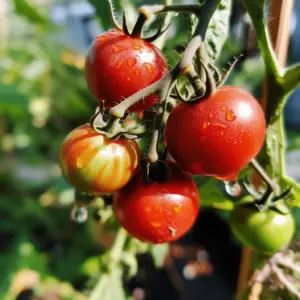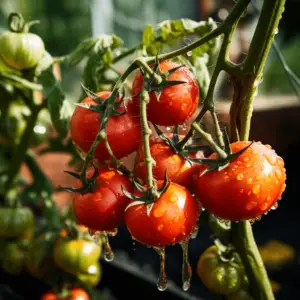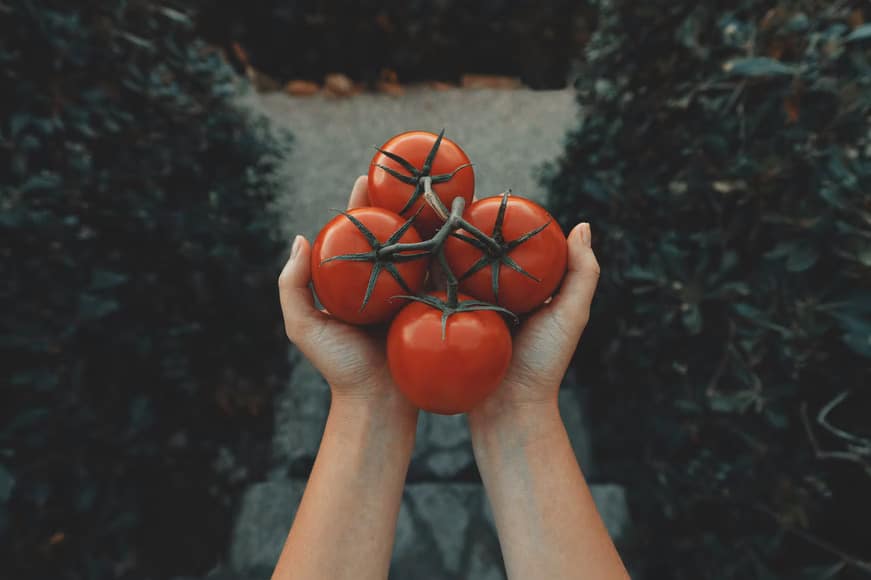Have you ever picked a tomato that is completely red except for a section of the bottom that is tan/brown? That’s blossom end rot, and you probably wondered if it was still ok to eat.
Before you throw that tomato away and curse the day you decided to plant tomatoes, here’s what you should know about blossom end rot.
Table of Contents
Can you Eat Tomatoes with Blossom End Rot?

It’s a big disappointment. You’re so excited to have a wonderful, fresh, homegrown tomato, and then you see it – blackened mush at the bottom of your tomato.
It’s frustrating because you put all this hard work into growing beautiful tomatoes, and then you end up with a bad one!
You may be wondering if you can eat tomatoes with blossom end rot? Well, yes! You can absolutely eat tomatoes with blossom end rot. Just scoop out the soft spots and enjoy your tomato! It’s completely harmless to humans, though it does make the fruit look unappetizing.
Grow tomatoes for the first time without giving up! You’ll be better prepared to feed your tomato plants and prevent blossom end rot next year!
What is Blossom end rot?
Blossom end rot is a condition that affects tomatoes and other plants in which the bottom ends of the fruit (“blossom ends”) become dark brown and leathery. Blossom end rot may also be referred to as “Black end.”
The black spots are just cosmetic damage. These spots can rapidly develop into larger areas where the flesh will be sunken and soft. When the water-soaked area enlarges, it can become a soft, wet mass susceptible to secondary bacterial and fungal invasion.
Blossom end rot is easy to recognize once you’ve seen it, but it can be mistaken for sunscald or funguses like early blight.
This condition only affects the fruit, not the leaves or stems of plants — though if you see blossom end rot on your tomatoes, check your peppers and squash for similar issues.
What Causes Blossom End Rot?
Bloom end rot (BER) is not harmful if eaten because it is not caused by E. coli. An erratic watering schedule or depth prevents the plant from absorbing calcium from the soil, causing the bottom cells of the fruit or vegetable to die and soften.
BER is a common occurrence among tomato plants during hot, dry seasons. It can occur at any stage of fruit development but most often affects young fruits.
Fortunately, blossom end rot does not spread from plant to plant. The plant will, of course, remain Blossom end rot infected, and this can be corrected by inhibiting or halting the infection.
Tomato blossom end rot is a frustrating problem, especially for beginners, as plant diseases tend to be. The good news is that blossom end rot is relatively easy to deal with.
Let’s take a look at how we can treat and prevent this tomato disease.
How to eliminate blossom end rot from tomatoes?
Calcium supplementation to correct a calcium deficiency
To help prevent blossom end rot, apply crushed eggshells to the soil at planting time or once a month. As the shells break down, they’ll add calcium to the soil.
Adding garden lime to the soil before planting tomatoes can help prevent blossom end rot. If you have this problem and need a quick solution, you can spray a calcium chloride solution on the plants once every two weeks or so. You can make your own solution to spray on tomatoes that have developed blossom end rot by adding 1/4 teaspoon of calcium chloride to 1 gallon of water and spraying it directly on your plants once every other week.
Maintain an adequate soil pH level (6.0-6.5)
If the pH of the soil is low, you should test it to find out how much lime it needs.
Before planting or six weeks before collecting ripe tomatoes, apply lime to the soil. This way, it can be blended into the soil to react with water and release calcium ions for plants.
How can I test my soil for calcium?
Soil testing for calcium requires sophisticated laboratory facilities not generally available to homeowners.
The best way to determine if your problem with tomatoes is due to a lack of available soil calcium is to dig up a plant and look at the roots. If they appear healthy, you can be fairly certain there is adequate soil calcium. If they are small and stunted, then you may want to consider adding lime to your garden next year.
Apply mulch to help conserve soil moisture and reduce weed growth
Organic mulch like shredded leaves, hay, or grass clippings (2–3 inches) can be put at planting or after plants have established themselves.
Use inorganic mulches like black plastic.
Use resistant varieties where available

Resistant varieties include BHN 968, Mountain Magic, Mountain Merit, Mountain Spring, and Phoenix.
While these varieties don’t guarantee immunity from the disease, they do provide greater resistance than other tomato varieties.
Do not over-fertilize your plants
High nitrogen fertilizers promote excessive vegetative growth at the expense of fruiting and can cause a calcium imbalance in the plant.
It will help if you rotate vegetables so that tomatoes are not grown in the same spot every year to help maintain soil nutrient levels.
Maintain an adequate soil moisture level
Watering deeply and less frequently is best. Shallow, frequent watering can lead to insufficient water uptake by the plant and encourage blossom end rot. Irrigate as needed to keep the soil moist but not wet.
Once you start watering again, ensure that your plants receive water consistently and deeply throughout the growing season.
Is there anything I can do at this point to alleviate BER on my tomatoes?
Once BER has set in, it cannot be stopped, but further damage can be avoided by maintaining consistent watering and fertilizer levels throughout the growth season.


